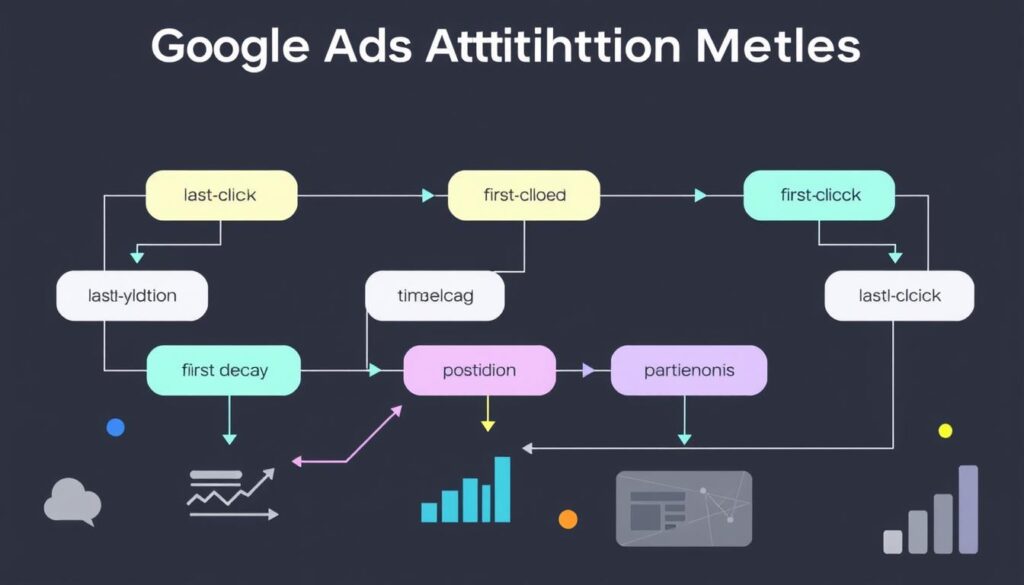In today’s fast-changing digital world, marketing has become more data-driven. This shift focuses on making campaigns better and getting more return on investment (ROI). At the center of this change is data-driven attribution. It’s a key tool for marketers to understand their marketing’s impact and make better choices to boost their performance.
Data-driven attribution uses advanced analytics and machine learning. It tracks and analyzes how customers interact with brands at different points. This method gives a detailed view of what really drives a customer to buy.

This approach is different from old methods that were simple or only looked at the last touchpoint. Data-driven attribution digs deep into customer behavior. It helps marketers fine-tune their strategies, use their budgets wisely, and increase their marketing ROI.
Key Takeaways
- Data-driven attribution uses machine learning and advanced analytics to track customer journeys and optimize marketing campaigns.
- It provides a more nuanced and accurate understanding of the drivers behind a customer’s purchasing decisions.
- Data-driven attribution enables marketers to make informed decisions, improve their marketing mix, and drive greater ROI.
- The use of machine learning and predictive modeling in attribution models can help identify patterns and predict future customer behavior.
- Implementing data-driven attribution can lead to significant benefits, including improved campaign performance, better budget allocation, and more efficient marketing strategies.
Understanding the Basics of Data-Driven Attribution
In the digital marketing world, knowing about attribution modeling is key. It helps in making smart choices and improving marketing plans. Data-driven attribution is a big help, offering a detailed and accurate way to follow the customer’s path.
Key Components of Attribution Modeling
Data-driven attribution focuses on the different points and interactions that lead to a sale. It looks at the whole journey and finds out which channels and campaigns helped the most. By understanding these key components of attribution modeling, marketers can see the whole customer journey.
The Evolution from Traditional to Data-Driven Attribution
Old attribution methods were simple, like last-click or first-click. But they didn’t show the full picture of the customer’s journey. Data-driven attribution uses advanced analytics and machine learning for a deeper understanding. This change helps marketers make better choices and get better results.
Core Principles of Data Attribution
The success of data-driven attribution comes from a few core principles of data attribution. These principles help in using and understanding attribution models well. By knowing and using these principles, businesses can really benefit from data attribution and make smarter, data-based choices.
“Data-driven attribution is the future of marketing analytics, enabling businesses to make informed decisions and drive sustainable growth.”
How Does Data-Driven Attribution Work
Data-driven attribution is a smart way to understand how customers move through their journey. It uses attribution algorithms to look at multi-touch attribution data. This gives marketers a clear view of what works best in their marketing.
This method tracks each customer’s interaction across different channels and devices. It breaks down the data to see how each marketing effort helps reach the goal. This way, marketers can see the real impact of their work.
Unlike old methods that only look at the last or first click, data-driven attribution uses advanced tech. It gives partial credit to each step a customer takes. This helps marketers decide where to spend their money for the best results.
| Metric | Traditional Attribution | Data-Driven Attribution |
|---|---|---|
| Touchpoint Credit | All credit to last-click or first-click | Fractional credit assigned to each touchpoint |
| Insight Granularity | Limited to high-level channel performance | Detailed analysis of individual touchpoint impact |
| Marketing Optimization | Difficult to determine true ROI and allocate budget effectively | Enables data-driven decision-making and optimized marketing mix |
By using data-driven attribution, marketers can really understand their customers. They can make choices based on solid data, leading to lasting growth and success.
The Role of Machine Learning in Attribution Models
In today’s world, machine learning and AI have changed attribution modeling. These technologies help marketers find important insights in customer data. This makes their attribution efforts more accurate and effective.
AI-Powered Attribution Analysis
Machine learning can analyze huge amounts of customer data. It finds complex relationships and touchpoints that humans can’t see. With AI in marketing, marketers understand the customer journey better. They can then give the right value to each marketing channel and touchpoint.
Pattern Recognition in Customer Journeys
Machine learning attribution is great at finding patterns and trends in customer behavior. It spots hidden connections, oddities, and how customers make decisions. This gives marketers a deeper understanding of their customers.
Predictive Modeling Capabilities
Machine learning attribution models use predictive modeling to guess future customer actions. They forecast how different marketing touches will affect customers. This helps marketers make better decisions and use their resources wisely.
As digital marketing keeps changing, using machine learning and AI in attribution will be key. Marketers will need these tools to stay ahead and get the most from their investments.
Benefits of Implementing Data-Driven Attribution
Using data-driven attribution can open up many benefits for your marketing. It goes beyond old ways of tracking, giving you a clearer view of how customers move through your journey. This helps you fine-tune your marketing to have the biggest impact.
One big attribution benefit is better budget planning. It lets you see which parts of your marketing really work best. So, you can put more money into the things that bring in the most ROI improvement.
Also, data-driven attribution boosts your marketing optimization. It helps you understand how different marketing channels work together. This way, you can find new ways to connect with customers and make their experience better.
“Data-driven attribution is a game-changer for marketing teams looking to maximize their impact and drive sustainable growth.”
The real value of data-driven attribution goes beyond just numbers. It’s a smart way to make choices based on solid data. This leads to better marketing and, in the end, better business results.
| Benefit | Description |
|---|---|
| Improved Budget Allocation | Identify the most effective marketing channels and campaigns to direct resources towards high-performing areas. |
| Enhanced Marketing Optimization | Uncover hidden insights, refine messaging, and deliver a more personalized customer experience. |
| Increased ROI | Make data-driven decisions that drive better business outcomes and measurable returns on your marketing investments. |
Data-Driven Attribution in Google Analytics 4
In today’s digital marketing world, knowing how your campaigns affect your performance is key. Google Analytics 4 (GA4) and its data-driven attribution help with this. It lets marketers dive deep into the customer journey and make better marketing choices.
Setup Requirements and Prerequisites
To use data-driven attribution in GA4, you need to set up a few things. Make sure your data is accurate, connect your marketing channels, and pick the right attribution model. A strong start leads to better results later.
Key Features and Capabilities
GA4’s data-driven attribution has many strong features. These include:
- Advanced machine learning for complex customer journeys
- Tracking of cross-device and cross-channel interactions
- Customizable attribution models for your business
- Integration with Google Ads for a complete view
Reporting and Analysis Tools
GA4’s tools help marketers understand their data-driven attribution. They include:
- Detailed reports on each touchpoint’s impact
- Predictive modeling for future campaign success
- Customizable dashboards for quick monitoring and decisions
By using GA4’s data-driven attribution, marketers can better understand their customer journeys. This helps them make smarter decisions for their how does data driven attribution work google analytics and GA4 attribution strategies.
Google Ads Attribution Models Explained
Understanding how does data driven attribution work google ads is key. The Google Ads platform has different attribution models. These models help advertisers see how their marketing efforts impact their campaigns.
Google Ads has many attribution models. Each model has its own way of giving credit for conversions. Here are some examples:
- Last Click: Gives all credit to the last ad clicked before the conversion.
- First Click: Credits the first ad clicked in the journey with 100%.
- Linear: Spreads the credit evenly across all touchpoints.
- Time Decay: Credits touchpoints closer to the conversion more.
- Position-Based: Credits the first and last clicks with 40% each, and the rest to other touchpoints.
- Data-Driven: Uses machine learning to assign credit based on each journey’s unique traits.
The data-driven attribution model stands out. It uses how does data driven attribution work google ads to give a detailed view of marketing performance. It analyzes lots of data to find patterns and insights that others might miss. This helps advertisers make better decisions and improve their campaigns.
| Attribution Model | Description | Key Advantages |
|---|---|---|
| Last Click | Attributes 100% of the conversion credit to the last ad clicked before the conversion. | Simple to understand and implement. |
| First Click | Assigns 100% of the conversion credit to the first ad clicked in the customer journey. | Emphasizes the importance of awareness and top-of-funnel activities. |
| Linear | Distributes the conversion credit equally across all touchpoints in the customer journey. | Provides a balanced view of the entire customer journey. |
| Time Decay | Assigns more credit to touchpoints that are closer to the conversion event. | Reflects the decreasing influence of earlier touchpoints over time. |
| Position-Based | Allocates 40% of the credit to the first and last clicks, with the remaining 20% distributed across the other touchpoints. | Recognizes the importance of both awareness and conversion-driving touchpoints. |
| Data-Driven | Uses machine learning algorithms to dynamically assign credit based on the unique characteristics of each customer journey. | Provides the most accurate and personalized attribution insights. |
Knowing the different Google Ads attribution models helps advertisers make better choices. They can decide how to use their marketing resources better. This way, they can get the most out of their how does data driven attribution work google ads campaigns.

Common Challenges and Solutions in Attribution Modeling
Using data-driven attribution models can face many challenges. These include data quality issues, integration problems, and implementation hurdles. It’s important to tackle these challenges to get the most from data-driven insights.
Data Quality Issues
Ensuring data quality is a big challenge in attribution modeling. Bad data can mess up the results, making insights unreliable. To fix this, companies need to focus on data governance, clean and combine data, and keep an eye on data quality.
Integration Challenges
Integrating attribution models with marketing tech can be tough. Different systems and data formats make it hard to share and analyze data smoothly. To solve this, companies should plan well, review their systems, and use data pipelines and middleware.
Implementation Roadblocks
Getting attribution models up and running can face many obstacles. These include resistance to change, lack of skills, and budget issues. To get past these, companies should train their teams, explain the value of attribution, and get support from top leaders.
By tackling these common challenges, companies can successfully use data-driven attribution models. This unlocks the power of data to improve marketing strategies and achieve better results.
| Challenge | Solutions |
|---|---|
| Data Quality Issues | Establish robust data governance practices Cleanse and unify data from multiple sources Continuously monitor data quality |
| Integration Challenges | Conduct system architecture reviews Implement data pipelines and middleware solutions Ensure seamless data sharing and analysis |
| Implementation Roadblocks | Engage in comprehensive training programs Communicate the benefits of data-driven attribution Secure executive-level sponsorship |
By solving these attribution challenges, companies can fully use data quality and integration. This leads to better business results through data-driven attribution modeling.
Best Practices for Data-Driven Attribution Success
Getting a data-driven attribution model right is key to boosting your marketing’s impact. To follow the best practices and make your marketing data-driven, try these strategies:
- Set Clear Goals and KPIs: Know what you want to achieve and how you’ll measure it. This makes sure your attribution model matches your business goals.
- Invest in Data Quality: Good data is essential for a solid attribution model. Check your data often and find ways to make it better.
- Connect Cross-Channel Data: Link data from all marketing channels to understand the customer’s journey fully. This helps you accurately see which marketing efforts led to sales.
- Use Machine Learning and AI: Advanced analytics can reveal insights in your customer data. AI attribution models help you make smarter, data-backed choices.
- Work Together Across Teams: Marketing, analytics, and IT should all work together for a successful attribution strategy. Agree on goals, data, and reports to make better decisions.
- Keep Testing and Improving: Always check and tweak your attribution model as things change. Try different methods and see what works best for your business.
By sticking to these attribution best practices, you can make your data-driven marketing strategy work well. This will help you get the most out of your marketing efforts.

“The true value of data-driven attribution lies in its ability to provide a clear, holistic view of the customer journey and the impact of each marketing touchpoint.”
Measuring ROI with Data-Driven Attribution
Organizations are working hard to get the most out of their marketing. It’s key to measure the return on investment (ROI) accurately. Data-driven attribution models give a deeper look into how well your marketing campaigns are doing.
Key Performance Indicators
When using data-driven attribution, finding the right KPIs is crucial. These might be things like revenue, cost per acquisition, and customer lifetime value. Tracking these helps you see how each step in the customer journey adds to your success.
Attribution Impact Assessment
Data-driven attribution does more than just track KPIs. It shows the real impact of your marketing. By looking at the data, you can see which channels and campaigns are most effective. This lets you improve your marketing strategy, use resources better, and make choices that boost ROI.
Read More: How to Set the Perfect Google Ad Budget for Success
FAQ
What is data-driven attribution?
Data-driven attribution uses advanced algorithms to track how customers move through marketing channels. It helps understand which channels lead to sales. This method is more detailed than older ways of measuring marketing success.
How does data-driven attribution work?
It looks at lots of customer data to see how each marketing touchpoint affects sales. Advanced models and machine learning assign credit to each step in the customer’s journey.
What are the benefits of implementing data-driven attribution?
It improves how marketing is done, helps with budgeting, and shows better ROI. It also gives a clearer picture of customer behavior and campaign success.
How does data-driven attribution work in Google Analytics 4?
Google Analytics 4 (GA4) has built-in data-driven attribution. Users can set it up and use advanced tools to see how well their marketing works.
What attribution models are available in Google Ads?
Google Ads has models like last click and first click. The data-driven model uses machine learning to figure out which ads led to sales.
What are some common challenges in implementing data-driven attribution?
Challenges include bad data, system integration issues, and implementation hurdles. Good data management and a solid plan can help overcome these.
What are the best practices for successful data-driven attribution implementation?
Success comes from clear goals, quality data, and tool integration. Regularly check and improve the model. A data-driven culture is also key.
How can I measure the ROI of data-driven attribution?
Track KPIs like marketing spend and revenue growth. This shows how well the attribution model works and its ROI.
𝐒𝐰𝐚𝐠𝐚𝐭 𝐆𝐚𝐰𝐚𝐝𝐞
Digital Marketer | Content Creator | Growth Strategist
With 2 years of hands-on experience in the dynamic world of digital marketing, Swagat Gawade specializes in crafting compelling strategies that drive growth and engagement. From managing ad campaigns to optimizing SEO, Swagat has a proven track record of boosting brand visibility and achieving measurable results.
Key skills:
𝐒𝐨𝐜𝐢𝐚𝐥 𝐌𝐞𝐝𝐢𝐚 𝐌𝐚𝐫𝐤𝐞𝐭𝐢𝐧𝐠: Building impactful campaigns that resonate with audiences.
𝐂𝐨𝐧𝐭𝐞𝐧𝐭 𝐌𝐚𝐫𝐤𝐞𝐭𝐢𝐧𝐠: Creating engaging, high-quality content tailored to target markets.
𝐒𝐄𝐎 & 𝐒𝐄𝐌 𝐄𝐱𝐩𝐞𝐫𝐭𝐢𝐬𝐞: Ensuring brands rank high and stay competitive in search results.
𝐀𝐧𝐚𝐥𝐲𝐭𝐢𝐜𝐬 𝐏𝐫𝐨𝐟𝐢𝐜𝐢𝐞𝐧𝐜𝐲: Leveraging data to refine strategies and enhance ROI.
Swagat’s passion for learning fuels a constant pursuit of innovative marketing solutions, making him a valuable asset in today’s fast-evolving digital landscape.


